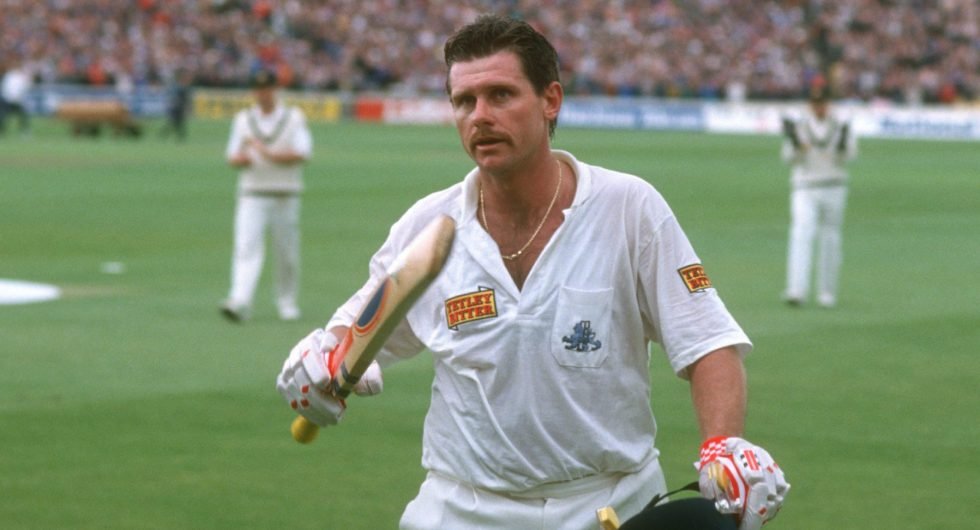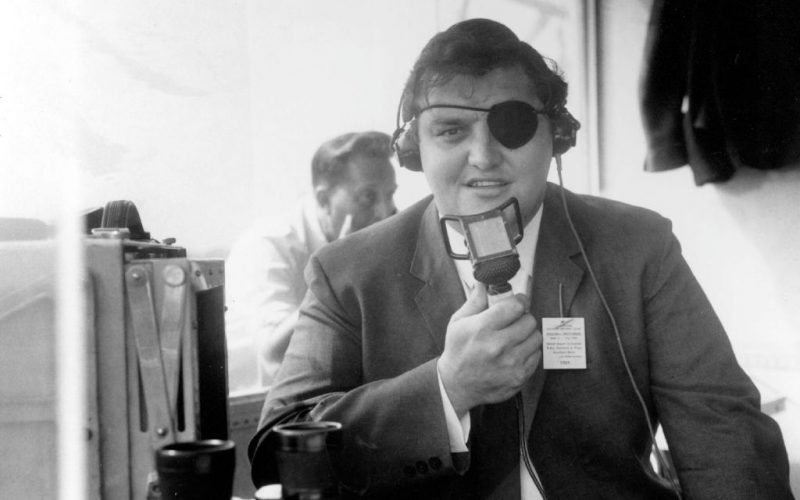From Robin Smith to Colin Milburn – 10 unfortunate England careers

Back in 2009, Ed Davis listed 10 players whose time in the limelight for England was shorter and less happy than it should have been.
Published in 2009
10. Robin Smith
62 Tests: 4,236 runs at 43.67
71 ODIs: 2,419 runs at 39.01
Robin Smith, ‘Judge’ to his legions of admirers, was a batsman who relished the thrill of facing fast bowling and possessed a cut shot that sounded like a backfiring cannon. He was, with Gooch, England’s most effective batsman during the early Nineties, and his brutal unbeaten 167 against Australia in 1993 is still the highest score by an Englishman in one-day internationals. There is a school of thought that Smith was simply ‘too nice’ for international cricket – his admission that he struggled against top-class spin (who doesn’t?) and his easy friendships with opposing players are cited as examples. It seemed that for all his talent, whenever England chopped and changed it was Smith who suffered. When he was finally dropped, following England’s 1995/96 tour of South Africa despite an assured half-century in the final Test, the overall impression was that England had discarded a man who still had plenty to give.
9. Wayne Larkins
13 Tests: 493 runs at 20.54
25 ODIs: 591 runs at 24.62
Blessed with enough natural talent for two batsmen, Wayne ‘Ned’ Larkins was a cavalier opener who never quite translated his obvious flair to the international stage. Larkins did himself no favours by joining the 1982 rebel tour of South Africa – as the resultant ban deprived England of much of his cricketing prime – but he was also unlucky that all but two of his 13 Test matches were against the powerhouses of his day, the West Indies and Australia. Who knows what he could have achieved given proper backing, although question marks persisted over his temperament: “He was an intense admirer of Gordon Greenidge and had all his skill and panache but only a smidgen of his hunger,” Simon Hughes once observed. “He was a simple man of simple pleasures. Offer him a bouncy wicket, a hearty lunch and a few beers, and he was happy.”
8. Martyn Moxon
10 Tests: 455 runs at 28.43
It’s always easy to blame the umpire for your misfortunes, but during England’s 1987/88 tour of New Zealand the men in white well and truly screwed Martyn Moxon over. Having been denied three runs early in his innings when a middled sweep shot was mystifyingly signalled as leg-byes, Moxon, almost inevitably, found himself dismissed one short of his maiden Test century.
The cruel hand of fate was not finished there. Moxon was 81 not out overnight going into the third day of the following match at Wellington, only for the heavens to open and the match to be rained off. After a summer being peppered by the missiles dished out by the visiting West Indian quicks and enduring the wretched ’89 Ashes series, he was dropped, never to return. He remains one of only nine men to have scored 99 in a Test career without also making a century.
7. Mark Lathwell
Two Tests: 78 runs at 19.50
England were in disarray during the ’93 Ashes series, scratching around desperately for someone, anyone, who could give the rampant Aussies a run for their money. Twenty-four players donned the Three Lions over the course of the summer, one of whom was a precocious opener from Somerset by the name of Mark Lathwell.
The hottest prospect on the county circuit, as well as the outstanding batsman during England A’s tour of Australia the previous winter, the English public were anxious to embrace the 22-year-old Lathwell as their new champion and the hype surrounding his debut at Trent Bridge rapidly ascended to fever pitch. He battled his way to 20 and 33, but his confidence visibly plummeted when he picked up a third-ball duck during his second Test at Headingley. He was dropped for the next match and was never the same player again, gradually becoming disenchanted with cricket before retiring in 2001.
In his autobiography, Marcus Trescothick lamented the circumstances that led to his former team-mate quitting the game: “I cannot overstate how brilliant Lathwell was. Sure, he found the experience of playing for England unnerving. The rumour goes that when Graham Gooch rang him up to tell him he was being left out… he mumbled something along the lines of ‘Thank God for that.’ But what a talent – a little bit of genius… when he tried a comeback he realised his heart was no longer in it, which was a tragedy for him and for English cricket.”
6. Andy Lloyd
One Test: 10 runs, no dismissals
There are few tougher introductions to international cricket than facing Malcolm Marshall on a flier, but that is the fate that befell Warwickshire’s 27-year-old opener, Andy Lloyd. Selected to make his Test debut on his home ground of Edgbaston, following some solid form in the preceding one-day series, Lloyd toughed it out for half-an-hour before a vicious bumper crashed into his helmet and handed him a full week in hospital and a healthy dose of double vision. Lloyd did not play again that season and was never selected for England again, although he battled back to play 299 first-class games for Warwickshire, and thus possesses the unique record of being the only player to open a Test innings and never be dismissed.
5. Martin Bicknell
Four Tests: 14 wickets at 38.78
Seven ODIs: 13 wickets at 26.69
It’s a sad world when 1,061 first-class wickets, the majority of them taken at the stubbornly unresponsive Oval, are insufficient to earn you more than four Test caps. Martin Bicknell was the bedrock around which the all-conquering Surrey side at the turn of the century was built. Like Lathwell, Bicknell made his Test bow during the ’93 Ashes series, but injury wrecked his chances of making England’s winter tour and from there on he was battling it out with Angus Fraser and Andy Caddick to share the new ball with Darren Gough. It was a battle that Bicknell, despite stacks of wickets and some 6,740 first-class runs, was destined to lose again and again. He did eventually have his moment in the sun. Surprisingly recalled, at the age of 34, to the Test side to face South Africa in 2003, he took a wicket with his first ball at Headingley and bowled England to a memorable, series-levelling victory on his home turf at The Oval. “It’s without doubt my fondest memory of playing for England; it’s the only Test match I played in that we actually won,” Bicknell observed. “To be on the winning side playing for England on your home pitch is going to stay with me for the rest of my life.”

The Surrey quartet of Bicknell, Butcher, Thorpe and Stewart celebrate England’s series win over South Africa in 2003
4. Harold Larwood
21 Tests: 78 wickets at 28.35
Few bowlers throughout history earned themselves such an intimidating reputation as Harold Larwood. A spell spent working in the coalmines of Nottinghamshire granted him formidable powers of strength and stamina, whilst his stature, he stood just 5’8” in his socks, meant that his horrible, lightening-quick bouncer homed in on the batsman’s ribs and jaw. A hard, intensely loyal man, he was a captain’s dream, prepared to bend his back on unresponsive pitches and bowl all day, so long as there was a beer and a cigarette to hand at the interval.
He was Douglas Jardine’s weapon of choice during the infamous Bodyline tour, utilised relentlessly and instructed to bowl through a painful foot injury at the SCG because Don Bradman, the principal target behind the ‘leg theory’ strategy, was still at the crease. The hostile, short-pitched barrage Larwood and Bill Voce, his partner-in-crime for Notts and England, subjected the Australians to was so potent that a diplomatic incident ensued.
Larwood, simply by doing what he had been told to do by his famously provocative captain, was made a scapegoat for the sake of the Empire. He never played for England again, a fate that tellingly did not befall Jardine – perfect evidence that there is one rule for bowlers and another for batsmen.
Injuries gradually took their toll and Larwood retired from first-class cricket in 1938. He immigrated to Sydney in 1950 and, to his immense surprise, was welcomed with open arms by a nation who recognised a steely, honest competitor when they saw one. It’s a shame the English hierarchy of the time could not say the same.
One of @englandcricket‘s greatest fast bowlers, Harold Larwood, died on this day in 1995.
His Wisden obituary recalled the career of a @TrentBridge hero.https://t.co/IUx4OuWjEr#wisdenobits #wisdenarchive
— Wisden Almanack (@WisdenAlmanack) July 22, 2020
3. Billy Bates
15 Tests: 50 wickets at 16.42
A tragic story, Billy Bates was a gifted, big-turning off-spinner and a good enough batsman to open for England, but his career was cut short during the 1887/88 Ashes tour when he was struck in the face by a cricket ball whilst bowling in the nets. The blow damaged his eyesight to such an extent that he was unable to continue his first-class career, an awful turn of events that drove him to attempt suicide. His sight eventually recovered enough for him to forge a second career as a coach in his native Yorkshire, but he was afforded little time in his new profession as he passed away at the age of 45.
2. Buddy Oldfield
One Test: 99 runs at 49.50
Some 88 cricketers have played a solitary Test for England, but none of the others scored more runs than Buddy Oldfield. Called up to face the West Indies at The Oval in August 1939, he shared a 131-run stand with Len Hutton on his way to making a composed 80 in the first innings and added 19 further runs in the second innings as the match wound its way to a hard-fought draw. A few days later the Second World War erupted, and when it eventually finished the 35-year-old Oldfield could not agree terms with his county, Lancashire, and retired to play league cricket, contenting himself with a record of 17,811 first-class runs, 38 centuries and one glorious Test cap.
1. Colin Milburn
Nine Tests: 654 runs at 46.71
The very epitome of the larger than life character, Colin Milburn, known to all and sundry as ‘Ollie’, was 18 stone of unadulterated raconteur, adored by public and players alike. He could play a bit too.

Colin Milburn lost sight in one eye after a car accident
Typically pictured with a grin from ear to ear, Milburn emptied bars whether batting or drinking. An opening bat for England, Northants and Western Australia, he had a textbook defence and wonderful hands; it was said that if a bowler strayed to leg he might as well have kissed the ball goodbye such was Millburn’s power. He was called up into the Test side in 1966 and immediately took to the international game, making 94 in his first Test against the mighty West Indies and smashing an unbeaten 126 at Lord’s. He was amazingly dropped because of his less than spritely fielding for the final Test of the summer, but won his place back the following year and in his final Test innings, during England’s winter tour of Pakistan in 1969, he dismembered a talented attack to the tune of 139 runs.
Sadly, Ollie was involved in a serious car accident later that year which cost him his left eye and, despite his brave efforts to resume his career in 1973 and ’74, a period where he made just one-half century, he was never the same player again. He maintained his high spirits as best he could, but sadly was struck down by a heart attack in 1990, aged just 48.
Published in 2009

